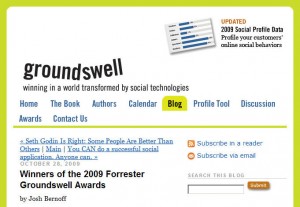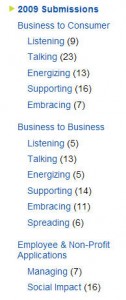When it comes to using Twitter for Investor Relations, one of the first issues to jump into people’s heads – especially people who went to law school – is how to comply with the wide range of rules and requirements that regulate corporate communications with investors. However, some simple strategies can help you avoid most IR difficulties.
Twitter and IR – What Are the Rules?
One of the difficulties in establishing a Twitter strategy for business and investor relations is the lack of formal rules or regulations. Many pundits point to the recent interpretive guidance published by the Securities and Exchange Commission in August 2008 in analyzing how the SEC stands on using online resources such as Twitter. However, this is badly misguided.
The guidance published by the SEC is specific to the official website of the corporation and has no applicability to un-owned, or uncontrolled websites and services such as Twitter. Indeed, the SEC guidance expressly details several features that must be present and several that should not be present on the company IR site in order to be recognized as acceptable under these guidelines. Obviously, the company will have no control in either adding or removing such elements from social networking sites such as Twitter.
Thus, the rules that apply to Twitter are the same rules that apply to all IR communications. The challenge, then, is not in finding and understanding new rules, but rather applying the old rules to a new venue.
Twitter Trouble Pitfalls
The issues that seem to raise the most concern are the improper release of inside or material information on Twitter. Ironically, this is likely to be among the easiest problems to avoid. After all, employees and executives in the IR Department have been dealing with this very same issue for years in every other existing form of media. The same training and experience that ensure that no investor relations professional makes inappropriate remarks during interviews, in emails, letters, or phone calls can provide the same security when it comes to posting official company tweets as well.
The real difficulty lies in being unable to implement the safety mechanisms that have been used by IR for years in communicating with the public. Many of the key phrases, approved wording, and the like are simply too cumbersome to fit into Twitter’s tiny allowable message size.
For example, an IR Department Manager named Lisa is heading up her company’s new real-time communications strategy on Twitter. Lisa is a smart, dedicated, employee with plenty of experience who understands the rules and regulations that govern investor communications. Her responses to many inquiries are well rehearsed and perfectly legal in every way.
Lisa is responding to a shareholder’s question, posted in breathless fashion as a tweet on Twitter, regarding the company’s recent decision to reduce the shareholder dividend in a difficult economic environment. The question insinuates many unfounded and negative fears and opinions about what happened to the dividend, and why. Lisa has already worked with upper-management and the legal department on how to best answer these queries and has done so numerous times since the decision was first announced. However, there is a growing chorus, mostly online, that the company is in dire trouble and that this is only the beginning of many terrible actions to come. Some are even claiming to have “inside” information, or a contact within the company that is secretly letting them in on how bad things really are.
This scenario is all too real and happens all too often. However, it is also precisely the kind of situation that can be helped quickly by using Twitter. The vast majority of muckrakers and naysayers on the web are not only misconstruing the situation, they aren’t even shareholders, and most have done no more analysis than read a concerned headline or two before drawing big conclusions. While such people will not be mollified by any communication, on Twitter or otherwise, the real shareholders and real analysts will take seriously an official reaction coming from the company.
Of course, this possibility has existed all along, for any shareholder willing to contact the company directly, or who has subscribed to communications from the corporation. Unfortunately, to many Main Street investors, these possibilities don’t occur to them, and instead, they assume that the company is encamped inside its corporate walls in deliberate, and telling, silence.
The value Twitter brings to IR communications is the ability to “pop-up” and provide answers to any user that has “followed” the company. Just as important, that same message can carry on second-hand, but still as an official answer, to the followers of anyone that re-tweets the company’s message. As an added bonus, the company’s official message will continue to be available on Twitter to those investors and potential investors whose concern comes after this particular wave, as an item they can reference and verify themselves simply by scrolling back through the company’s tweets.
Of course, these same factors are the reason it is critical to get the message right the first time.
Just Too Big for Twitter
The answer Lisa wants to give goes something like:
“While the Board of Directors recognizes the company’s long history of increasing dividend payments, as well as the importance of the dividend to the company and its shareholders, it was determined, after analyzing several possibilities and consulting with both management and other experts, that it was in the best long-term interests of both the company and its shareholders to reduce the dividend at this time.”
 Obviously, this is much longer than 140 characters (414 characters according to my word processor). The danger arises as Lisa tries to pare down the language to fit into Twitter’s restrictive size requirement.
Obviously, this is much longer than 140 characters (414 characters according to my word processor). The danger arises as Lisa tries to pare down the language to fit into Twitter’s restrictive size requirement.
The difficulty lies primarily in attempting to reconstruct the non-committal nature of such statements with the intention to communicate the possibility of improvements more to the shareholder’s liking. For example, note how the statement gives the impression that this reduction is neither permanent, nor standard course, but avoids stating either explicitly. It also vaguely alludes to the fact that other alternatives were considered, though it makes no mention of how seriously those options were looked at, nor how much more appealing those alternatives might have been to stockholders. This statement also tries to position the company and shareholders on the same side, while stopping short of any characterization of the company action as it relates to shareholder wishes.
Not to mention, when given in writing, this statement is no doubt included with a disclosure statement.
All of this is accomplished with the careful consideration of exactly what words are used. Trying to recreate the same effect with fewer words is tricky at best. In fact, a typical “forward looking statements” disclosure takes more than 140 characters. (Just the phrase forward looking statements is 26 characters.)
In order to successfully execute a social media strategy, investor relations executives like Lisa, need a solid, reproducible strategy to ensure that they create useful, ongoing, tweets, without opening the company up to additional liability. Fortunately, a few simple tricks can give any IR Department all the latitude they need to create and respond to posts on Twitter.
In my next post, see what Lisa and other Investor Relations Groups Need: Complete Twitter Strategy Rules for Investor Relations.


